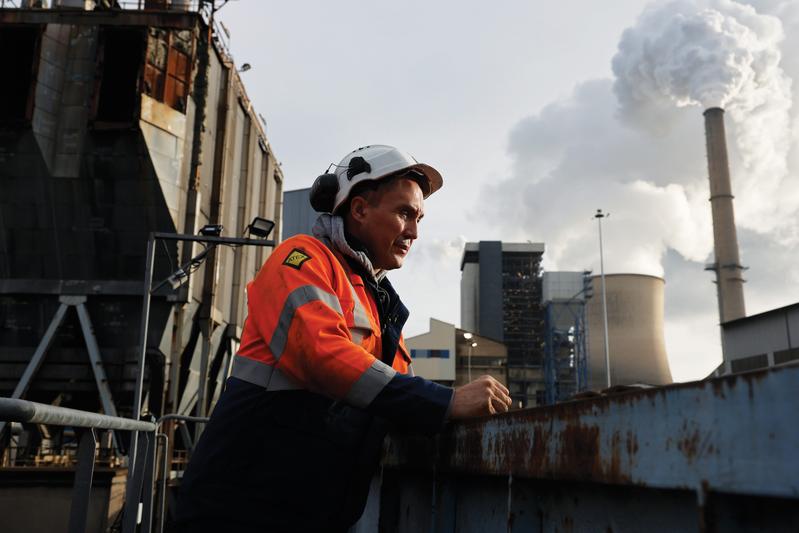EU nations forced to look across the Atlantic for energy, security support
 Sylvain Krebs, in charge of coal supply, looks on from the coal-fired power station on Nov 29 in Saint-Avold, France. The plant should have been closed permanently at the end of last winter, but the government resumed its operation due to the energy crisis. (PHOTO / AP)
Sylvain Krebs, in charge of coal supply, looks on from the coal-fired power station on Nov 29 in Saint-Avold, France. The plant should have been closed permanently at the end of last winter, but the government resumed its operation due to the energy crisis. (PHOTO / AP)
Editor’s note: As Feb 24 marks the one-year anniversary of Russia’s special military operation in Ukraine, China Daily is reviewing how it has reshaped geopolitics, impacted the global economy and aggravated the energy crisis.
The United States and NATO seem to be the sole beneficiaries from the yearlong Russia-Ukraine conflict and appear willing to prolong the fighting and even bleed Ukraine to the last man standing, according to analysts.
Regional observers say the conflict between Russia and Ukraine dates back as early as 2014, but it was only events in February last year that brought it to the attention of the wider world. One year on, the US and some of its NATO allies keep sending weaponry to Ukraine, while Europeans have to buy high-priced US fuel.
The conflict has resulted in a warming of trans-Atlantic relations, a dramatic revival of NATO and a setback for the EU’s strategic autonomy, said Ding Chun, director of the Center for European Studies at Fudan University in Shanghai.
Before the conflict, NATO was described as “brain dead” but last year Finland and Sweden submitted applications to join the alliance, while Japan and South Korea started to join NATO-initiated projects.
Although the pace of Sweden becoming a member is being slowed by Turkiye’s opposition, NATO in general has managed to further extend its reach closer to Russia and China.
Sweden, holding presidency of the European Union Council, announced the EU’s 10th round of sanctions against Russia following long discussions on Feb 24, less than two hours before the end of the one-year anniversary of the conflict.
The new sanctions include expanding export restrictions on technological and industrial products regarded as vital to Russia’s economy and military capability, including further export bans worth more than 11 billion euros ($11.6 billion). All 27 EU member states must approve the sanctions for them to take effect.
Simultaneously, Washington’s “football game” on the battlefield in Ukraine brings fortunes to defense and energy businesses in the US.
Replacing the military equipment transferred to Ukraine by NATO allies could lead to some $21.7 billion in foreign military sales or direct commercial sales for US businesses, the US Foundation for Defense of Democracies said in a January report.
The US State Department said US weapons sales to Europe rose by 49 percent last year from $34.8 billion in 2021.
Germany was one of the biggest US arms buyers in Europe, ordering 35 F-35 fighter jets and munitions and equipment worth $8.4 billion in July.
On Feb 24, the US Defense Department announced additional security assistance to Ukraine that includes several new unmanned aerial systems, a counter-unmanned aerial system to bolster Ukraine’s defense and electronic warfare detection equipment.
As for the energy industry, US President Joe Biden admitted in his State of the Union address on Feb 7: “Big Oil just reported its profits. Record profits. Last year, they made $200 billion in the midst of a global energy crisis.”
Last year the US exported nearly 10 million cubic meters of Liquefied Natural Gas to the EU a month, 137 percent more than in 2021, providing about half of all of Europe’s imported LNG.
France’s Finance Minister Bruno Le Maire and Germany’s Economy Minister Robert Habeck have both accused the US of profiting from the Ukraine conflict and energy crisis by making Europe dependent on its LNG.
Roderick Parkes, research director of the German Council of Foreign Relations, wrote in a paper in January that the Ukraine conflict has accelerated a 15-year trend in Europe that has pushed political authority away from a Franco-German core toward the fringes and front-line states, “away from the north-south axis of Paris and Berlin toward an east-west one now bracketed by the UK and Poland”.
The conflict has prompted the EU to break its taboo of not providing arms to countries involved in military conflict and has prompted many member states to increase their defense budgets, Ding said.
Lai Suetyi, a researcher at the Center for European Studies at Guangdong University of Foreign Studies in Guangzhou, said the conflict “brings Europe, as well as the world, back to the past, the Cold War past”.
Such a large conflict in Europe reminds Europeans why they started the European integration project, she said.
As the US and its allies supply more weapons to Ukraine, peace activists have voiced their objections and are organizing demonstrations across Europe to call for a halt to the escalation of the Russia-Ukraine conflict.
Contact the writers at chenweihua@chinadaily.com.cn



